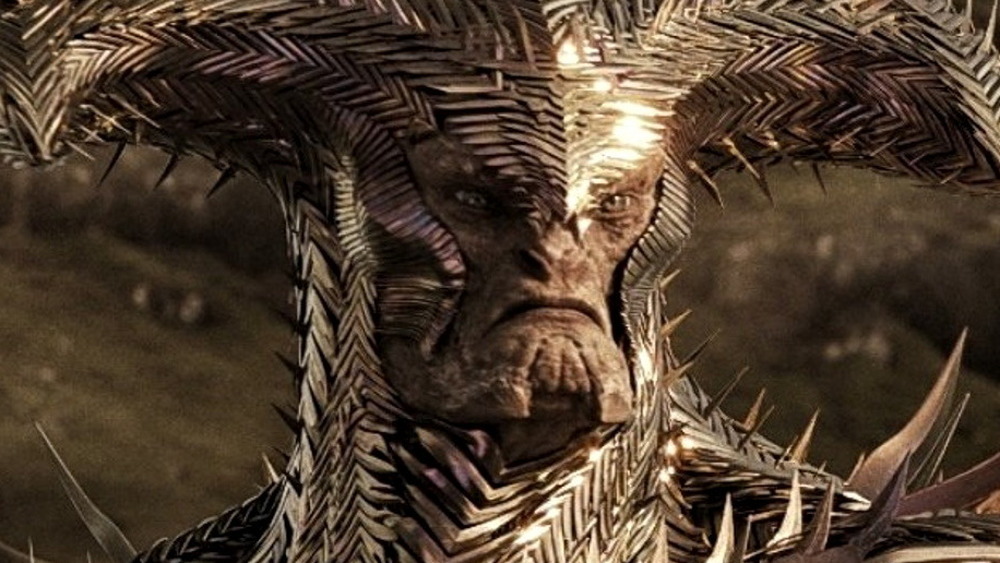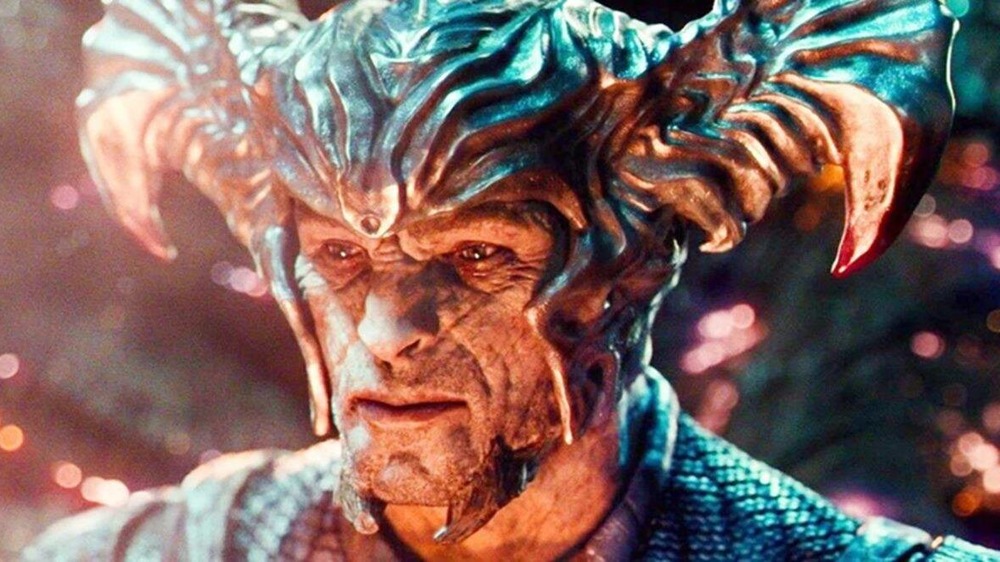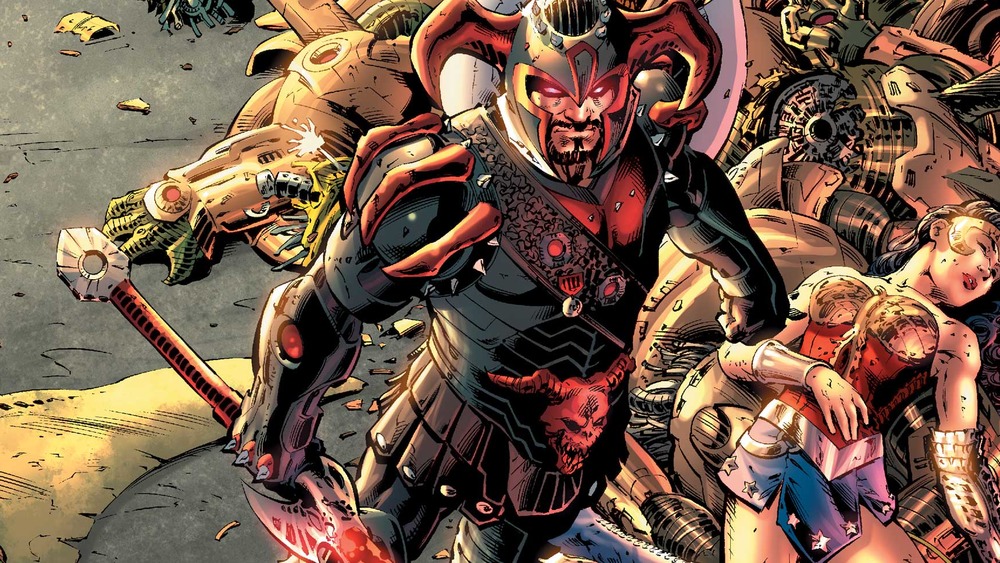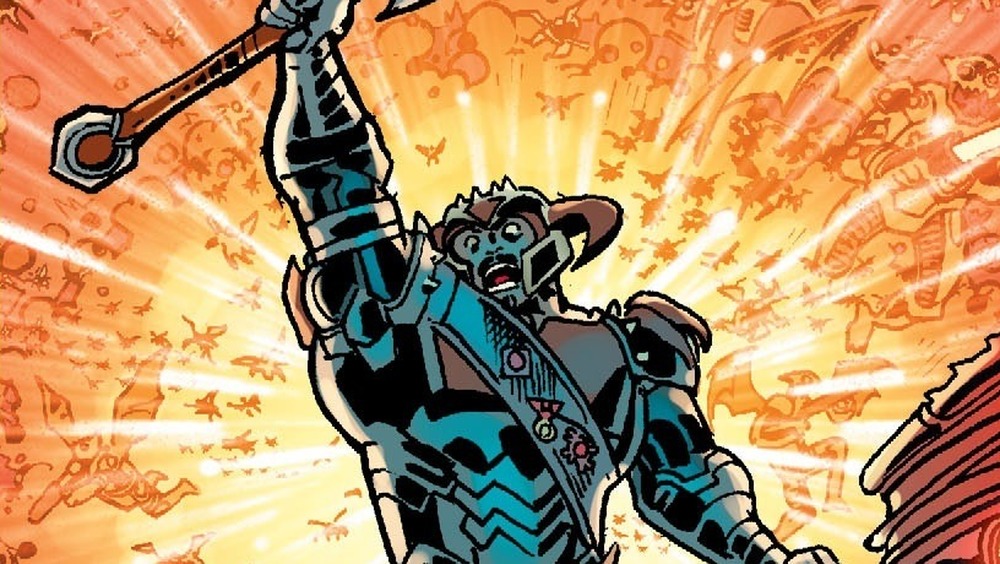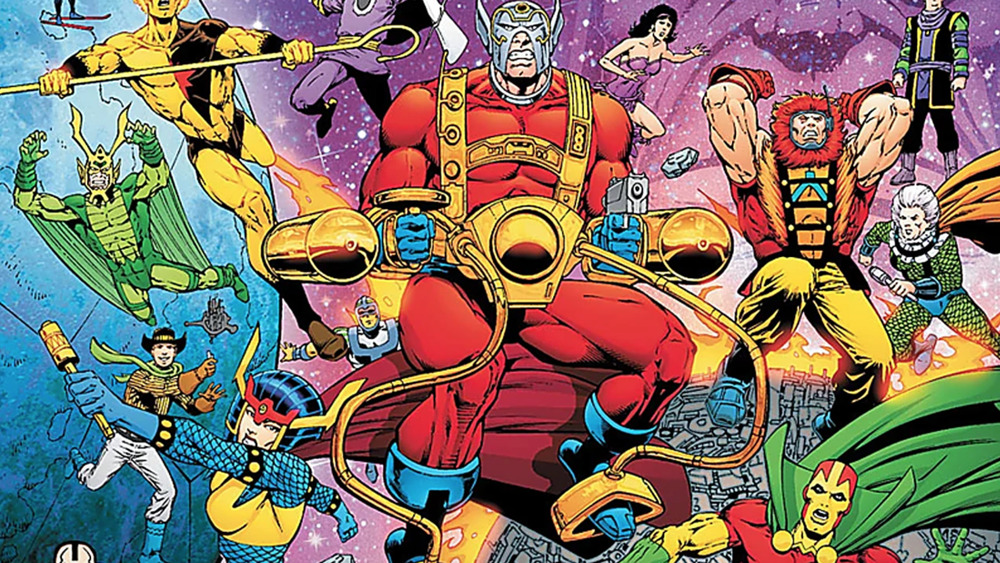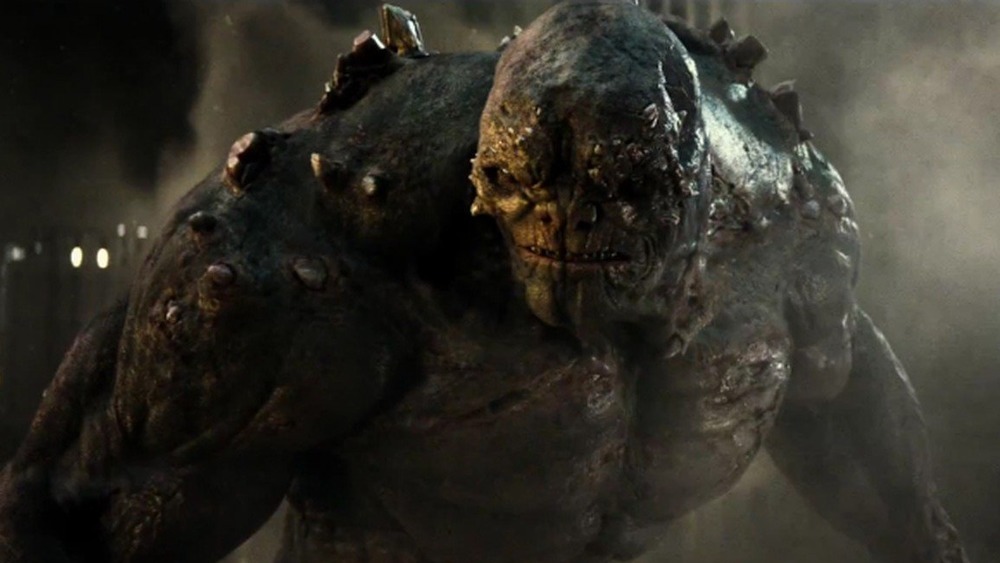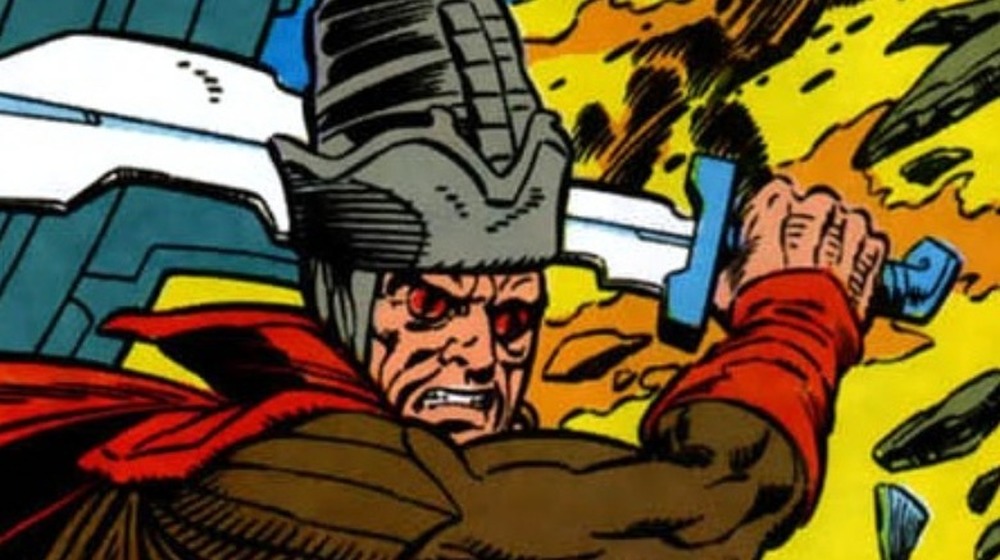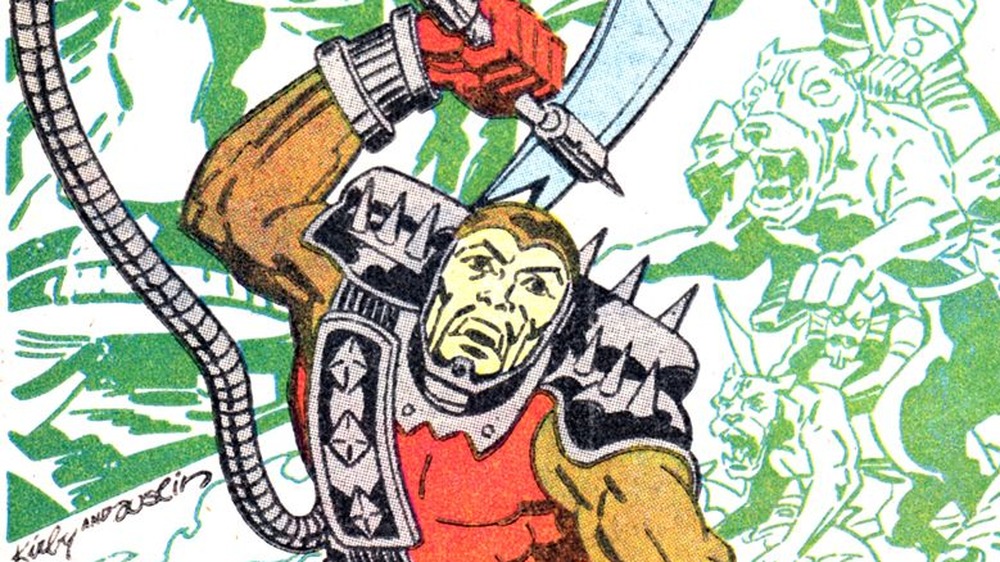The Untold Truth Of DC's Steppenwolf
If you click a link and buy a product or service from a merchant, we may be paid an affiliate commission.
The main antagonist of Justice League is Steppenwolf, a dishonored general from Apokolips who once failed to conquer Earth and, as punishment, was banished. In the original film, his motivations begin and end at trying again — and, naturally, hoping he doesn't fail (which, of course, he does). He even fails for a third time in the Snyder Cut – and for four whole hours! At least he looked better doing it (by alien standards).
Despite boasting such a major big screen appearance, Steppenwolf has remained somewhat unknown to the general public, which is a shame given his rich history in the source material. Steppenwolf first entered the DC scene in 1972 in the pages of Jack Kirby's New Gods (via DC Comics), two years after the debut of his lord and master, Darkseid. Despite not being in charge of Apokolips, Steppenwolf has proven important enough to survive multiple retcons, which is more than can be said for other once-prominent members of Darkseid's elite, such as Virman Vundabar and Amazing Grace. Who are Virman Vundabar and Amazing Grace, you ask? Exactly.
Unless you've paid close attention to comic book history, though, Steppenwolf's importance to the DC universe at large might go unnoticed. Let's fix that, shall we? Here's a brief crash course in the most prominent member of Darkseid's elite squad of devastating lieutenants to feature in Zack Snyder's Justice League, now streaming on HBO Max.
Steppenwolf: the hideous love child of Jack Kirby and DC
Right about now you're probably re-reading that intro and saying to yourself: Wait a minute. Isn't Jack Kirby a Marvel guy? What's he doing moonlighting over at DC, inventing evil gods? Fair question.
Turns out: Kirby spent some time over at DC after his first imperial run inventing some of Marvel's most memorable heroes alongside Stan Lee. It seems that Kirby felt a bit underappreciated what with Lee's increasing celebrity. In an attempt to step out from his media-savvy partner's shadow, he struck out on his own, signing an exclusive three-year deal to work his Kirby magic for the rival publisher.
Eager to surpass Lee, Kirby wanted to go big with his DC debut. He envisioned a massive expansion of the DC universe via three interconnected series that would introduce expansive science-fiction worlds and technologies, as well as elements of popular pulp genres of the time like space opera, to the world of Batman and Superman. Kirby named this project "Fourth World," and with it he hoped to tell stories with existential stakes on a galactic level. Steppenwolf and Darkseid were born of this grandiose aspiration, and to be honest, we're lucky they're still around, because Kirby's master plan kinda fell flat for DC readers.
The Fourth World series were all quickly and unceremoniously canceled due to lack of sales (via Gizmodo). Kirby bid DC adieu and went back to dance with the girl who brought him for a bit, before venturing forth into the wild world of indie comics. Kirby did come back to DC during the Reagan administration to see to his destructive creations. He apparently wanted to kill them all off definitively, but DC had attachment issues even then, and a standing policy of denying the finality of death. As a result, Steppenwolf and the other New Gods got to stick around in various conflicting incarnations long after their creator's time with them was done.
Steppenwolf and Darkseid (along with the other New Gods) have been perhaps the most enduring products of this brief sojourn for Kirby across town. The real-world origin story of these characters goes a long way to explaining their difficult birth into DC, and the epic retconning that took place for decades thereafter.
Steppenwolf is part of a large, complex, and dangerous family
So now we know that Steppenwolf is one of the New Gods, a race of beings who reside on the twin planets of Apokolips and New Genesis, that were created by Jack Kirby in the '70s during Kirby's brief-but-passionate affair with rival comics shop DC. You can think of Apokolips and New Genesis as two halves of the Manichaean worldview that was so omnipresent in older comics — before all that postmodernism seeped in from the book culture at large, pushing creators to acknowledge shades of moral complexity and complicate the motivations of heroes and villains alike. None of that nonsense in New Gods. In the Fourth World stories, New Genesis good; Apokolips bad.
New Genesis is a futuristic utopia at peace with itself, and brimming with astonishing technology. It basically looks like the future we were promised in the 1950s. Apokolips ... Apokolips looks more like the future we actually got. Other Apokoliptian New Gods include such fascistic residents as Darkseid and Granny Goodness, and like most godly pantheons, all of these characters have strange and twisted familial relationships. The authoritarian ruler of Apokolips known as Darkseid (originally born Uxas), is the son of the New Gods Yuga Khan and Heggra. While little is known of Yuga Khan's family — assuming he didn't kill them and strike them from Apokoliptian records — Heggra has one known blood relative of note, and that's Steppenwolf. Yes, this means that Steppenwolf is Darkseid's uncle.
However, given that Darkseid is currently the most powerful New God alive — and has an absolutely horrific temper — Steppenwolf would be a fool to try and take the throne from him, despite being his elder. Then again, Steppenwolf seems to like his current position as commander of Apokolips' military, since it lets him lead his forces into bloody battle. He's been at it since the reign of Yuga Khan and Heggra, and since failure on Apokolips is usually rewarded with death (if they're lucky), it's safe to say Steppenwolf must be pretty good at what he does.
Steppenwolf once started a big, big war
Apokolips is one of the most technologically-advanced planets in the DC Universe, and it likewise houses one of the most powerful militaries. The only force that keeps the world in check and protects the rest of creation is its antithesis, New Genesis. Since the planets are essentially oil and water — albeit, with wormhole technology and laser pistols — you might assume they would wage an eternal war with one another.
Once upon a time, they did — and it was all Steppenwolf's fault.
Ever since Darkseid was born, he schemed against anyone who stood in his way to claim the throne of Apokolips. This included his parents, his older brother Drax, and even his uncle Steppenwolf. While Drax was easy enough to eliminate, Steppenwolf took a little more finesse. So, Darkseid convinced him to participate in the popular Apokoliptian pastime of hunting down and killing New Genesisians. One of Steppenwolf's targets was the leader of New Genesis, Highfather Izaya, but Izaya's wife, Avia, sacrificed herself to save him. Following this, Izaya slew Steppenwolf in revenge ... and thus, the war between New Genesis and Apokolips was started.
Of course, Darkseid eventually resurrected Steppenwolf and put him in charge of the military of Apokolips. Because, you know, comics.
Steppenwolf the unkillable
When Jack Kirby set about to create his New Gods, he probably didn't realize just how big a role these godly beings would come to play in the greater DC Universe. If he did, he might not have killed off so many of the major players so fast. Indeed, the vast majority of Steppenwolf's appearances in Jack Kirby-penned works happen in flashback sequences. His New Gods #7 debut, which tells the story described above, wherein Steppenwolf is (temporarily) killed, was itself a flashback story. Though the death obviously didn't take, the flashback frame of New Gods #7 means that Steppenwolf was functionally dead upon arrival in the DC Universe.
Kirby's 1985 miniseries Super Powers brought Steppenwolf back, though this limited run was published as a toy tie-in for Kenner Toys, and isn't considered canon. It wasn't until DC published Who's Who: The Definitive Directory of the DC Universe, that Steppenwolf's entry clarified it was, indeed, Apokaliptian technology administered by his nephew, Darkseid, that brought him back to the world of the living. Kirby also gave his revenant creation a major redesign for New Gods Vol. 2, the same arc in which Steppenwolf first appears as Darkseid's military commander of choice.
Confused yet? Let's go ahead and add a whole throng of new creators and decades worth of retconning in to the Steppenwolf equation.
Steppenwolf survived an encounter with Doomsday — and saved Darkseid's life
The monstrous being known as Doomsday is known for being unstoppable. After all, if even Superman can't defeat an enemy, the odds are most other heroes (and villains) can't either. Seeing as Doomsday is the ugly poster child for this trope, since he famously killed Superman, it's worth noting that Steppenwolf somehow survived an encounter with this creature years before Kal-El was even born (via DC Comics). Even more impressive is that — ever the loyal uncle — he saved Darkseid from an early grave in the process.
Darkseid's fight with Doomsday began thousands of years ago, after the lord of Apokolips — in an attempt to obtain the chemical reserves of Bylan 5 — ran afoul of Krypton's greatest monster, in a stroke of cosmically bad luck. Doomsday hurtled himself into the way like the organic, spikey meteor he is, and he tore through Darkseid's forces. Even Darkseid almost fell before Doomsday's unstoppable onslaught ... but Darkseid was rescued at the last minute by Steppenwolf. However, since Darkseid's word is law, and it might be embarrassing to acknowledge such a massive near-defeat, he and Steppenwolf agreed to never speak about this rescue ever again.
Steppenwolf used to be stuck in the past
In comics, the space-time continuum is a malleable canvas that changes to suit the narrative. Sometimes, a story is linear, and other times, it relies on flashbacks to tell a tale. Other other times, a comic steps back in time to tell a story disconnected from the current comic timeline.
As mentioned above, despite Steppenwolf's importance to the history of Darkseid — and Apokolips in general — his early stories mainly kept him in the past. His first appearance in 1972's New Gods #7 – which holds numerous stories — was a depiction of how his murder of Avia started the Apokolips-New Genesis war. Many of his subsequent appearances, as well, have featured stories that take place well into DC's past. In the DC Universe, Steppenwolf is a part of ancient history, and it's not entirely clear if Kirby ever expected him to play such an active role in the present.
That changed a bit as the New Gods became increasingly integrated with other stories. While Steppenwolf never became a mainstay in the DC Universe in the same way Darkseid did, as time went on, stories that included Steppenwolf have become more likely to take place in contemporary times, as seen in The New 52 reboot. DC's New 52 initiative brought change to just about every corner of the DC Universe, and despite Steppenwolf's god-like abilities, he wasn't immune. Among many, many other things, The New 52 introduced a fresh version of Earth-2 to the DC multiverse. It's there that Steppenwolf first staged a massive invasion of the blue planet with a seething horde of parademons. You may recall the parademons from Justice League the movie. The ensuing battle results in some pretty significant deaths on the hero side (but only the inferior Earth-2 versions), and by the end Steppenwolf decides to cool his heels in that universe, dodging a $300 million bounty on his head.
Steppenwolf's had some major redesigns over the years
If you think the difference between Snyder's Steppenwolf and the one in the 2017 version of Justice League is noticeable, well, his comic book design has been all over the place, and the iconic horned helmet he now wears is a relatively recent addition.
When Steppenwolf first appeared, for instance, his look could be best described as "medieval-punk", with lime green skin, green armor and belts, a green cape, and a pointy green hat that couldn't decide if it belonged to a wizard or a pirate. This is the design that also made it to the DC Animated Universe, in shows such as Superman: The Animated Series.
However, for a time, comics abandoned this classic look for the one above, featuring an orange-red getup with spikes, and a giant axe connected to his back. Where did this design come from? Den of Geek hypothesizes that toys were to blame.
While DC has produced its fair share of toy lines, one of the most endearing ones is the classic Kenner Super Powers series, which were simple figures with equally simple gimmicks. While the first series focused on the Justice League's A-listers, and villains Lex Luthor and the Penguin, the second wave branched out to feature Darkseid and his villainous forces. The design went on to appear in Mister Miracle comics and beyond, and while subsequent DC cartoons returned Steppenwolf to his original green threads, the electro-axe became a mainstay of his armory. Never underestimate the power of a marketable toy design.
